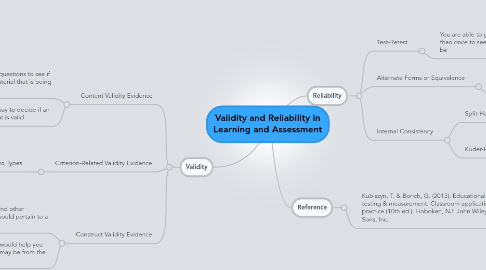
1. Validity
1.1. Content Validity Evidence
1.1.1. Able to inspect test questions to see if they relate to the material that is being tested
1.1.2. Simplest way to decide if an assessment is valid
1.2. Criterion-Related Validity Evidence
1.2.1. Two Types
1.2.1.1. Concurrent Criterion-Related Validity Evidence
1.2.1.1.1. "Deals with measures that can be administered at the same time as the measure to be validated (Kubiszyn & Borich, 2013)."
1.2.1.2. Predictive Validity
1.2.1.2.1. This will help teachers predict how well the students will do on the test
1.3. Construct Validity Evidence
1.3.1. Information on the test and other information on the test would pertain to a theory
1.3.2. Information from the exam would help you determine what the results may be from the test
2. Reliability
2.1. Test-Retest
2.1.1. You are able to give the test more than once to see how reliable it can be
2.2. Alternate Forms or Equivalence
2.2.1. If there are two equal forms of an assessment then they can both be given to see if the test is reliable
2.3. Internal Consistency
2.3.1. Split-Half Method
2.3.1.1. Able to split the test in to two parts and score separately to see if the test is reliable
2.3.2. Kuder-Richardson Methods
2.3.2.1. These methods take two test and see how they can relate to each other to see if an overall test is reliable

